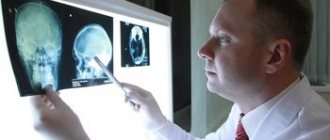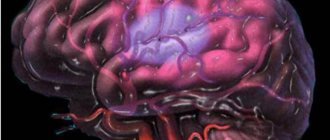Description of other types of diseases starting with the letter “T” here: Toxic encephalopathy; Torsion dystonia; Traumatic encephalopathy; Peripheral nerve injuries; Transient global amnesia; Transient ischemic attack; Cavernous sinus thrombosis; Tuberculous meningitis; Brain tuberculoma; Tuberous sclerosis.
What is toxic encephalopathy?
Toxic encephalopathy is a disease characterized by a combination of neurological disorders that are provoked by the influence of toxic components, toxic substances and industrial chemicals. The clinical picture of the anomaly is numerous. It depends on the etiology of occurrence and may include ataxic and convulsive syndrome, hallucinations, disorders of the speech apparatus, visual ability, hearing, cognitive reflexes, damage to cranial elements, and characteristic rashes on the skin. During diagnostic procedures, doctors resort to applying the information obtained after collecting anamnesis, the results of a standard examination, laboratory tests and instrumental examinations. Antidote, detoxification, pathogenetic and symptomatic treatment methods are used as therapy.
Clinical picture
Alcoholic encephalopathy has 2 forms:
- acute alcoholic;
- chronic form - alcoholic pseudoparalysis, Korsakov psychosis.
Less common are other forms of the disease, the cause of which is the consumption of different types of wine.
Features of the period of development of the disease:
- asthenia;
- adynamia;
- lack of appetite;
- painful thinness;
- nausea and vomiting - in the morning;
- diarrhea;
- stomach ache;
- belching;
- heartburn;
- constipation;
- sleep disturbance;
- profuse sweating;
- heart pain;
- dyspnea;
- lack of air;
- numbness, pain and aches in the limbs;
- disturbance of consciousness;
- anxiety;
- speech disorders;
- coma - in severe cases;
- twitching of the tongue, lips, face;
- problems with eye function;
- puffiness;
- temperature is above normal;
- skin is dry, flaky or greasy;
- bedsores;
- dizziness;
- nervous disorders;
- memory loss;
- disorientation;
- polyneuritis;
- epilepsy attacks.
The diagnosis is determined against the background of studying information about the occurrence and development of the disorder and clinical picture data.
Quick Facts
Encephalopathy of toxic origin is considered a severe form of intoxication. According to average statistical indicators, the largest incidence of deviations from the norm is caused by addiction to alcohol (up to 18%) and drugs (up to 13%). In third place are poisonings caused by inhalation of heavy metals (for example, lead, mercury, manganese) and affect 5 to 7% of individuals. Defeat strikes workers at manufacturing plants or mining companies. The highest frequency of TE diagnosis is found in the employed population in the age category from 25 to 55 years. By gender, the disease is observed more often in males.
The main sources of development of toxic encephalopathy
All toxic anomalies are formed as a result of the entry into the body of harmful substances that enter the central nervous system. The causative agent can be single contact or consumption, as well as prolonged oversaturation with the toxin. Therefore, doctors distinguish two forms of the disease: acute and chronic. Common factors in the development of the disorder include:
- Abuse of alcoholic beverages and narcotic drugs - during prolonged use of increased dosages of alcohol, as a result of which a deficiency of vitamin B develops. The use of drugs (heroin, amphetamine, cocaine, etc.) has a serious impact on the performance of the central nervous system.
- Labor activity in enterprises where there is a harmful effect on the employee’s body - the source of toxic encephalopathy is long-term contact with methanol, lead, mercury, organophosphorus compounds, carbon monoxide during the working day at a factory and in a mine.
- There is a possibility of getting an anomaly as a result of the consequences of a man-made disaster or the mistaken ingestion of food with a large amount of a chemical.
- Increasing the dosage of medications and neglecting the instructions of the attending physician cause a harmful process that disrupts the functioning of the central nervous system. The reaction to the development of toxic encephalopathy is influenced by antidepressants, non-steroidal anti-inflammatory components, benzodiazepine components, etc.
- Liver or kidney disease - since these organs are responsible for eliminating toxic metabolic products when they are severely deficient, the patient begins to accumulate exogenous poisons, natural metabolites, toxic ammonia and organic acid.
Relatives' eye disease
In a situation where the patient does not agree to see a doctor on his own because he does not see the need for this or cannot describe changes in his condition, the family psychiatrist asks the relatives what worries them about the behavior of their loved one.
It is family members who initiate treatment for encephalopathy in the absence of criticism from the patient.
The severity of symptoms and their combination may vary at different stages of the disorder, but relatives or friends say that a loved one:
- became uncollected, absent-minded;
- gets easily irritated and lashes out at relatives;
- became more demanding, intolerant;
- weak-hearted, easily cries for no apparent reason;
- forgets about important dates, current events and plans;
- has difficulty performing normal tasks;
- withdraws from his routine duties;
- looks depressed, but cannot explain the reason for the bad mood;
- has difficulty remembering any words or names;
- uncritical of ongoing changes;
- could get lost on the street, stopped going to familiar places;
- sleeps poorly at night, sleepy during the day.
Mechanism of occurrence
In the 21st century, the pathogenesis of various forms of TE has not been studied in detail and remains questionable. Scientists were able to establish a clear connection between clinical history and morphological deformations that occur in the nervous system. Doctors say that the basis of the disease is the influence of a toxic drug and disruptions in the functioning of the blood supply system to the brain, as a result of injury to the cerebral vessels. Such a harmful process provokes degenerative-dystrophic disorders in soft tissues and the formation of swelling of the meninges. Patients develop disruptions of hemodynamic and liquorodynamic nature, which further worsens the toxic and hypoxic effect on the central nervous system. Subsequently, the patient develops necrotic zones in the cortex and subcortical areas, and fragmentation of myelin structures.
If a certain element is taken into account, doctors are able to identify specific features. They can be associated with the increased sensitivity of parts of the nervous system and the ability of dangerous compounds to accumulate in internal objects of the body.
First aid
First aid if alcoholic encephalopathy of the brain is suspected has the following specifics:
- you need to wrap the person well in a blanket to keep warm;
- make sure that if there is vomiting, the patient does not choke on the vomit;
- wait for the ambulance to arrive.
One should not discount the condition as a result of which a person falls into a coma.
In this case, you should trust your doctors.
It should be borne in mind that even if you get out of this state with the help of medications and the help of doctors, this will not go away without consequences for the body, because it receives extreme stress.
Symptoms
The manifestations of the disease depend solely on the toxin ingested. In case of overdose of salicylates, the first thing observed is:
- Weakness.
- Nausea with periods of gag reflex.
- Sharp ringing or noise in the ear canal.
- Speech problems.
- Visual and auditory hallucinations.
- Convulsive seizures, cognitive impairment, and coma are rare.
In case of carbon monoxide poisoning, the patient is diagnosed with:
- General cerebral manifestations.
- Memory disorder.
- Hallucinations.
- Complete or partial loss of coordination ability.
- Hypertonicity of the muscular skeleton.
- Hyperkinesis of choreic nature.
- Depression of consciousness.
When hydrogen sulfide intoxication occurs, the patient experiences acute pain in the head area, dizziness, small-scale tremor, intoxication, inhibited movements, etc.
Mercury toxic encephalopathy is distinguished by the first symptoms of dysfunction of the vegetative-vascular system and neurasthenia syndrome, which are combined with serious gastrointestinal problems. Subsequently, the patient develops tremor of a large swing, fearfulness, a high level of suggestibility and other “mercury erethisms,” cerebellar ataxia, dementia, and a disorder of the speech apparatus.
Lead poisoning is characterized by rapid deterioration of visual function, central paralysis and weakening of the motor pathway of the nervous system. Rarely there are situations that manifest themselves in damage to the motor and mixed cranial regions, epilepsy. A characteristic symptom of lead TE is the presence of a light gray rim that forms on the teeth.
Manganese encephalopathy is characterized by low muscle pressure, lethargy, drowsiness, emotional jumps, gait disturbance, forced smiling or laughter, uncontrolled movements of the tongue and lips. With severe intoxication, “manganese madness” begins
Complications and consequences
The consequences of the disease coincide with its symptoms and are special for each type of encephalopathy.
Alcoholic encephalopathy has the following consequences:
- high blood pressure;
- heart disorders;
- heartburn;
- disturbances of eye functions;
- muscle disorders;
- trophic disorders;
- imbalance;
- neuralgia;
- stiffness of movements.
Complications:
- fetal alcohol syndrome;
- dementia;
- speech disorder;
- partial memory loss;
- schizophrenia;
- brain tumor;
- inability of the brain to work;
- urinary and fecal incontinence;
- neuritis;
- paralysis of limbs;
- epileptic seizures.
Diagnostic methods
To prescribe procedures for examining a patient, the neurologist initially collects information about the patient, finds out about the presence of complaints, and checks the results of physical, laboratory and instrumental tests. The general research program for the probability of the presence of TE consists of the following features:
- A detailed collection of all available complaints and information effectively helps to determine the toxin that caused the disorder.
- The doctor focuses on the nature of speech ability - the presence of dysarthria or incoherence in the story.
- A standard body examination is carried out.
- During the physical examination, the patient's pulse is measured, blood pressure is measured, the condition of the superficial layer of skin and visible mucous cavities is examined, and the volume of active and passive motor capabilities is assessed to look for paresis, paralysis and uncontrollable muscle twitching.
- An examination of the cranial nerves, vision and hearing levels is carried out.
- General clinical laboratory tests (CBC, OAM, biochemical testing of blood cells) are prescribed.
- Electroencephalography will be required in case of convulsive spasms and profound impairment of consciousness.
- Additional diagnostic techniques are electromyography, spinal tap, computed tomography or MRI scan of the brain, toxicological assessment of hair and nails.
How is the treatment carried out?
The main goal of therapy is to completely rid the patient of the chemical element, reduce brain disorders, and correct neurological deficits. Based on the severity of the patient’s general condition, the treatment course can be carried out in the clinic of the neurological department, the intensive care unit or the intensive care unit. Treatment includes:
- To remove the toxic component of their body, doctors perform gastric lavage with distilled water or medical reagents, then prescribe enterosorbents.
- Detoxification procedures are aimed at binding or eliminating chemicals that have entered the blood. The patient is prescribed intravenous injections of plasma substitutes and clinical antidotes, hemodialysis, etc.
- Symptomatic and pathogenetic methods - use mask inhalations with oxygen, mechanical ventilation, the use of pharmacological drugs with antiepileptic and diuretic effects, tranquilizers, corticosteroids.
Prevention
{banner_banstat9}
The set of measures includes:
- monitoring blood glucose levels;
- monitoring blood pressure and taking appropriate medications;
- eradication of alcoholism;
- refusal of alcohol;
- good nutrition;
- healthy sleep;
- playing sports.
All patients are very different from each other, so the treatment algorithm is drawn up taking into account the individual characteristics of the patient.
But the main condition for successfully combating the consequences of the disease is detection of the disorder in the early stages
and timely treatment.









